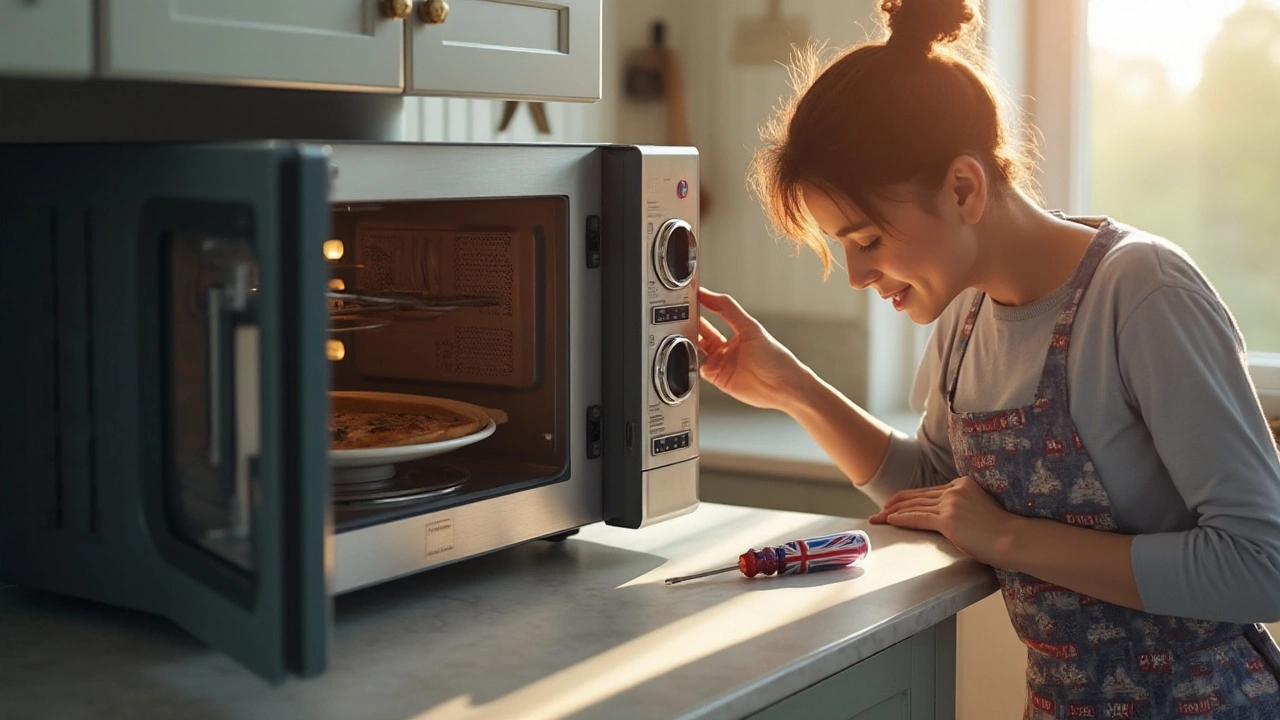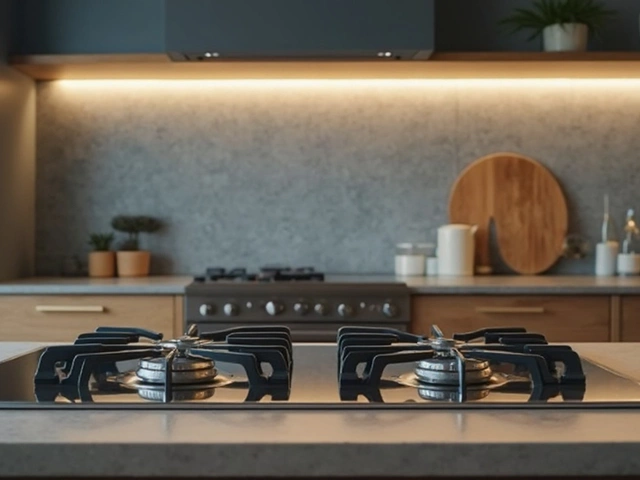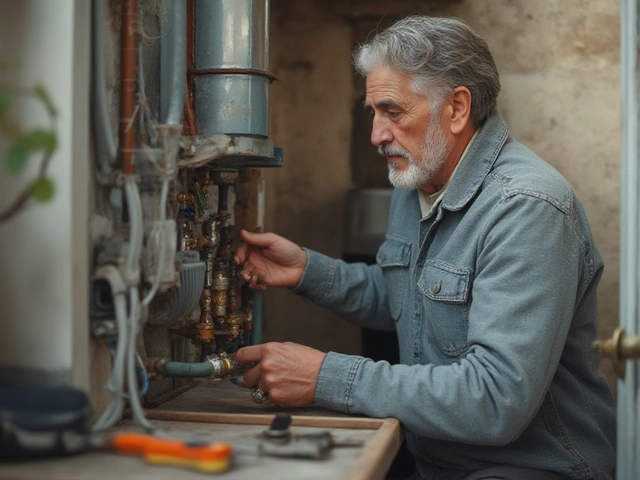The microwave has become an indispensable part of our daily routine, making meal preparation quicker and more convenient. However, like any appliance, it's susceptible to wear and tear, and understanding what tends to go wrong can help prevent a complete breakdown.
In this article, we delve into the common issues that plague microwaves and offer some handy troubleshooting advice. From understanding the inner workings of your microwave to knowing which problems you can fix yourself—and when it's time to consult a professional—you'll gain practical knowledge to keep your microwave in top shape.
- Understanding Microwave Components
- Common Microwave Malfunctions
- Diagnosis and Repair Tips
- Maintenance to Prevent Future Issues
- When to Call a Professional
Understanding Microwave Components
The microwave oven, a staple in modern kitchens, works due to a fascinating convergence of various components that bring together heat, electricity, and a little bit of science to warm your food efficiently. If you peel back the metallic casing, you'll find a complex ecosystem of parts working in harmony. At the center of it all is the magnetron, the key player responsible for producing the microwave's unique heating pattern. A magnetron generates microwave radiation by converting electrical energy, typically provided by a high-voltage power source, into the radio waves that cook your food. This mysterious alchemy is what allows a microwave to heat from the inside out, making it quicker than conventional methods.
Supporting the magnetron is a delicate symphony of diodes and capacitors. The high-voltage diode is there to ensure the correct flow of electricity, allowing the magnetron to perform efficiently. Without this diode, the microwave might fail to heat, leaving your cold leftovers pitifully untouched. Meanwhile, capacitors act like miniature energy reservoirs, storing the electricity needed to power the magnetron robustly. They offer stability to the microwave's energy flow, ensuring it runs smoothly without fluctuations. So, if a microwave is not working as expected, these components are often the first to inspect.
"Understanding the components inside the microwave oven isn't just interesting—it can often lead to DIY fixes that save you time and expense," says Emma Richardson, an appliance repair expert from TechFix. Her insights remind us of the often overlooked potential of learning our appliances inside out.Besides these key players, there are other components like fuses, which act as safety nets. The microwave fuse shuts down the entire operation if it detects a power surge, preventing dangerous electrical faults. A failed fuse might be a minor issue, easy to replace but critical for safety and functionality. Another element is the turntable motor, which ensures that your food heats evenly. If it breaks down, you'll notice inconsistent heating patterns, as the microwave isn't rotating your food properly.
Other equally crucial components include the control panel and the door switch. While the control panel, often a digital interface, allows you to set the cooking time and power levels, the door switch guarantees the safety of your microwave's operation. Both need to be in peak condition for a functional microwave. If your microwave doesn't start, checking the door switch and ensuring it clicks correctly can often resolve the issue. When you understand these individual components of a microwave, you aren't just empowered to troubleshoot but are better equipped to communicate potential issues to a repair professional if needed.
Common Microwave Malfunctions
It’s surprisingly easy for microwaves to encounter various problems, primarily because they are packed with different components that endure constant use. One of the most talked-about microwave problems is when it stops heating. Often, this can be attributed to a faulty magnetron, which is an essential piece of equipment that uses high voltage to produce the energy needed for heating food. If the magnetron burns out, it needs replacing, a task best left to those familiar with microwave repair.
Another frequent issue is a sparking microwave, which can be an alarming sight. This usually results from leftover food particles or grease in the oven cavity, leading to arcing. The mica plate or waveguide can become damaged if sparks are regular, so it’s crucial to keep the interior clean and inspect the plate for any signs of damage. Sometimes, using kitchen foil inadvertently can cause sparking, so ensure that none is left in the appliance.
A non-turning microwave plate can also be problematic, as it limits the even distribution of microwave energy. This typically happens due to a malfunctioning drive motor or a broken plate switch. Checking the roller guide and coupler for blockages or defects is the first step in solving this puzzle. Should the motor be defective, a replacement is likely the solution, given safety precautions are followed strictly.
The strange smell or smoke emanating from a microwave is usually due to an electrical issue such as a damaged capacitor, diode, or transformer. These components are crucial, and while they can be replaced, it often requires specialized knowledge and tools. Since these parts store electrical charge, they can be hazardous to handle without proper care or expertise.
"Maintenance and regular checks can prolong the life of your microwave and prevent untimely breakdowns," advises Harold Melvin, a certified appliance repair technician with over 20 years of experience in the field.
Lastly, a microwave’s touchpad not responding is another issue many face. This can be due to a defective touchpad or control board, sometimes resulting from moisture or debris. Inspecting and cleaning the touchpad might help, but if it remains unresponsive, consulting a professional is the best practice to avoid further damage. Remember, proper care and maintenance significantly increase the lifespan of kitchen appliances, saving both time and money in the long run.
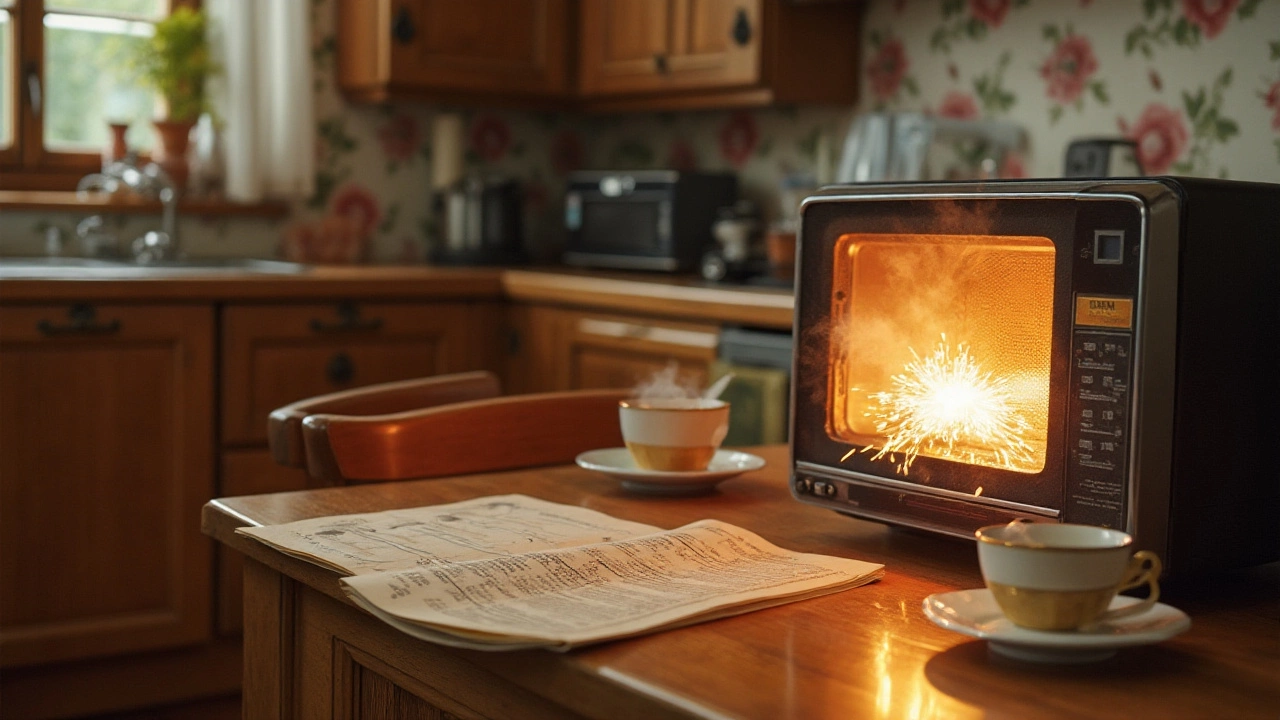
Diagnosis and Repair Tips
When your trusty microwave starts acting up, it can throw a wrench in the usual convenience of your kitchen routine. But diagnosing and fixing common problems can be more straightforward than you may think. Armed with some basic knowledge, you can tackle many issues yourself, saving time and the potential cost of professional repairs. It's crucial to approach each problem logically and step-by-step, using all your senses to observe what's wrong. Whether it's refusing to heat or making strange noises, each symptom could point to a different fault that you might be able to rectify.
A frequent culprit behind a malfunctioning microwave is a blown fuse. The microwave's fuses protect against electrical surges or overheating, but if they fail, the microwave won't function at all. Checking the fuse is often the first step: start by unplugging the microwave and accessing the fuse panel, which is usually located near the power cord. Replacement requires a fuse rated for your specific model, and having this knowledge can often get your appliance back up and running swiftly.
Another typical problem lies with the door switches, which are part of the safety interlocking system. If the microwave thinks its door is open, it won't turn on. This can be usually diagnosed by checking if the light inside stays on or the machine doesn't run when the door is shut. In most cases, you can resolve this by tightening screws or replacing the switch. However, always double-check you're using the right parts to avoid further complications that might arise from improper repairs.
"Don't forget that microwaves can be dangerous when not handled properly," warns home appliance specialist Martha Klevens. "If you're unsure about checking components like high-voltage capacitors, consulting with a professional might be the safest bet."
If heating issues persist, it might be worth looking at the microwave's diode or capacitor. Both play a pivotal role in converting AC to DC, essential for producing the high-intensity heat microwaves require. Signs that these elements may need replacing include no heat or intermittent heating. Testing and replacing them demands careful handling due to the voltage involved. Remember that if you're not confident about dealing with electrical parts, safety should always be your top priority.
Adopting a preventive maintenance approach can minimize the hassle of unexpected breakdowns. Regular cleaning and ensuring no vent blockages can extend your microwave's lifespan significantly. Small checks can detect potential issues early, and investing in routine services with an experienced technician can also be beneficial in the long run.
Maintenance to Prevent Future Issues
Keeping your microwave in good working order requires diligence and a proactive approach. One often overlooked aspect of maintenance is regular cleaning, which can significantly impact its performance and longevity. Food splatters and spills build up over time and can obstruct the microwave's vents. This buildup not only leads to unpleasant odors and possibly even fires but can also force the appliance to work harder, wearing out critical components prematurely. To avoid these issues, it's essential to clean both the interior and exterior surfaces regularly, using a mild detergent and a soft cloth. Pay special attention to the door seal area, which can trap food particles and reduce the efficiency of your microwave's cooking power.
Ensuring that your microwave is effectively ventilated is another key to its maintenance. Microwaves need to dissipate heat effectively, and blocked vents can lead to overheating and damage. Make it a habit to periodically inspect the grills and vents for dust and debris. Cleaning them with a vacuum cleaner or a soft-bristled brush is a simple way to maintain proper airflow. Additionally, consider where your microwave is positioned in your kitchen. It should have a minimum clearance of several inches around it to ensure sufficient ventilation. An often-cited resource, "The Kitchen Appliance Handbook," notes,
"Most microwave malfunctions originate from poorly maintained ventilation systems, which could easily be resolved with regular checks and cleaning."
Another critical aspect of microwave maintenance is to regularly check the condition of its power cord. A damaged cord can spell trouble, presenting risks of electrical shocks or even fires. It is essential to inspect the power cord periodically for any wear, fraying, or cracking and replace it immediately if any issue is found. Additionally, ensuring the cord is not bent or crimped can prevent future damages. For those who frequently use their appliance, investing in a surge protector can safeguard against power surges potentially damaging the microwave's delicate electrical components.
Keeping an eye on your microwave's maintenance means understanding the demands placed on its components. The light bulb, which often goes unnoticed, can indicate other potential issues when it fails too frequently. If the light burns out or flickers, it might signal voltage issues in your microwave that require professional attention. Don't ignore these symptoms as they can help diagnose larger problems before they become more severe.
A simple yet effective preventive measure includes the use of a microwave oven cover. This inexpensive accessory prevents food splatter and makes routine cleanup easier. Additionally, make sure to use microwave-safe containers to prevent damage or discoloration. Not all plastic is rated for microwave use, and non-approved materials can melt or leach chemicals into your food. Regular checks and adherence to best practices are integral in prolonging the life of your microwave. By implementing these straightforward, consistent habits, your microwave will not only operate more efficiently but will also minimize the risk of major breakdowns, ensuring your investment serves you well for years to come.
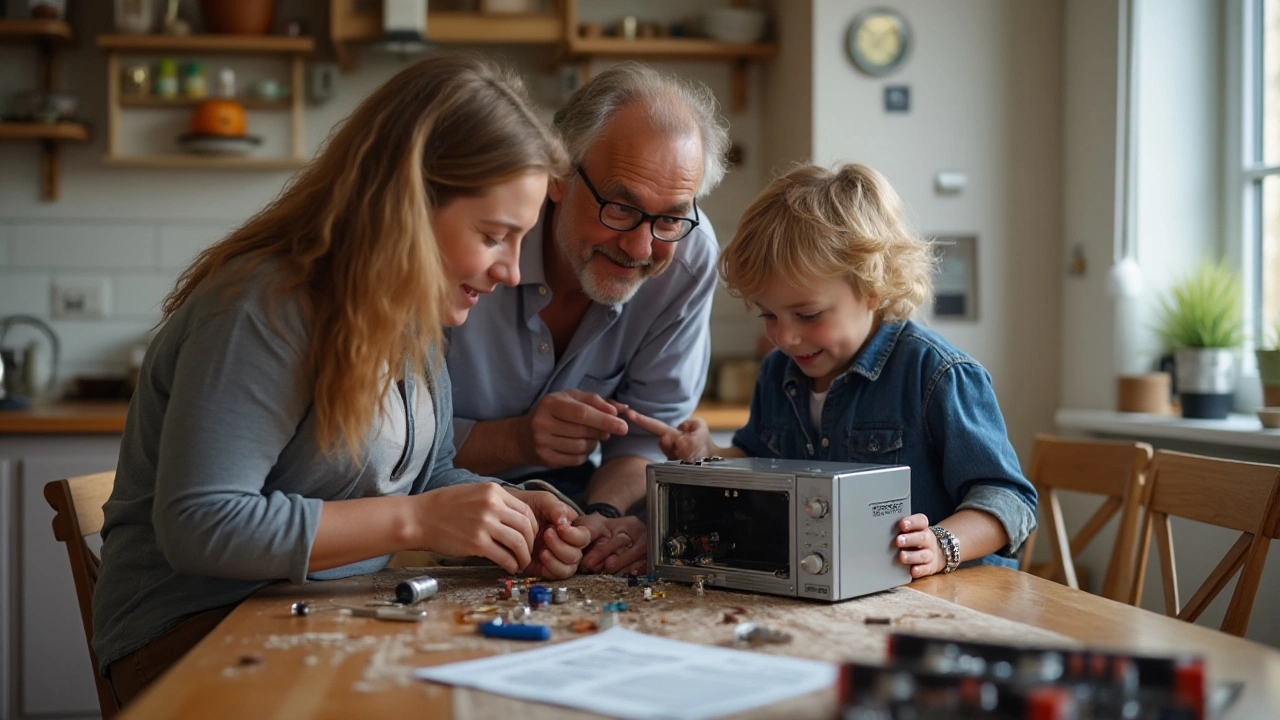
When to Call a Professional
A microwave is a wonderful appliance until it decides to throw a tantrum at the worst possible time, leaving you with cold leftovers and a headache. While some microwave problems can be handled with a screwdriver and a hint of patience, there are situations where calling a repair professional becomes not just smart but necessary. So how do you know when it’s time to let go and call in the experts?
One of the top reasons to call a professional is when you find yourself dealing with electrical issues. Microwaves run on high voltage, and tinkering with these components without proper expertise and tools can be dangerous. If you notice the microwave trips your house's circuit repeatedly or shows signs of electrical arcing (think sparks or smoke), it’s time to step back. A simple misstep can cause serious injury or further damage the appliance. Once you have safety considerations on the forefront, such tasks are best left to those trained in handling electrical elements.
Another sign that professional help is needed emerges when despite your best efforts, the microwave simply won’t heat. The heating element, known as the magnetron, is a common culprit in such scenarios. Replacing this key component not only requires specific tools but also can be expensive, and a professional will be able to assess whether it’s worth repairing or replacing the whole appliance. Remember that even minor replacements require precision to avoid disrupting the microwave's electromagnetic functionality.
"Working on appliances with a qualified technician ensures the job is done safely and efficiently, avoiding future breakdowns." — Appliance Maintenance Basics by Consumer Reports.
Complex mechanical problems such as those involving the drive motor or turntable mechanism often require a professional touch. If you notice the microwave’s turntable isn’t spinning, you might check to see if something is blocking its path. But if the motor is failing or grinding noisily, this can be a signal that internal components need detailed attention. Without the right tools and replacement parts, trying to fix these issues yourself can lead to more trouble than it’s worth.
Assessing the Cost of Repair
Budget also plays a critical role in deciding when to call a professional. In many cases, labor fees coupled with the cost of new parts might approach the price of a new microwave. Published statistics show that once repair costs hit 50% of the price of a replacement, many consumers lean towards buying new. In such scenarios, a professional's insight can be invaluable, helping you weigh the viability of investing in repairs against the benefits of purchasing a more efficient, up-to-date model.
Therefore, when things go awry, don't just assume it's a simple DIY project. Reach out, inquire, and make use of expert advice. By knowing when it's time to call in the professionals, you protect not only your wallet but your well-being, ensuring that your kitchen appliances work safely and effectively.

